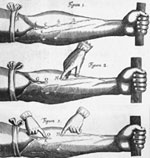William Harvey -
By his discovery of the circulation of the blood, Harvey revolutionized
physiology which had been based on the assumptions about how materials flow
through the blood vessels
|

William Harvey |
 |
He is the first to describe correctly and in detail
the systemic circulation and properties of blood being pumped to the body by the
heart. Many doctors still relied on Galen for much of their knowledge, but
Harvey liked to experiment. Harvey experimented on animals to prove that Galen
was wrong, proving the same blood circulated around the body. In 1628 he
published his work so anyone could do his experiments. His ideas gave birth to
modern medical practices like transfusions. Harvey contemplated a vast research
programme on the motions of the heart , respiration , animal locomotion and
generation, the functions of the brain and various other topics , but only his
work on the heart and on generation of animals actually came out in print in
Latin in 1628.
More importantly, his work was one of the major
triumphs for modern science , as it helped to generate the enthusiasm for
science. Harvey proved his theory on the pathway of blood flow and that blood
impelled mechanically by pump-like action of the heart. He measured the amount
of blood in any given unit of time , which was one of the first applications of
quantitative methods in biology.
Harvey’s doctrine of the primacy of the blood, which
he had already begun to develop when he wrote his lecture notes in 1616, can be
summarized as follows:
All other parts of the body originally receive life
from the blood, and thereafter the blood continues to be the main repository of
heart and vitality ; its constant circulation through the body serves not only
to nourish all other parts but also to sustain their heat , spirits , conceptive
powers , sensibility and contractility . Thus the blood alone is truly alive per
se , and the rest of the body is an appendage that serves the blood and lives by
virtue of it.
The first English edition of Harvey’s 72 page book
on “The motions of the Heart and Blood “appeared in 1653. It was a landmark in
the field of science. |